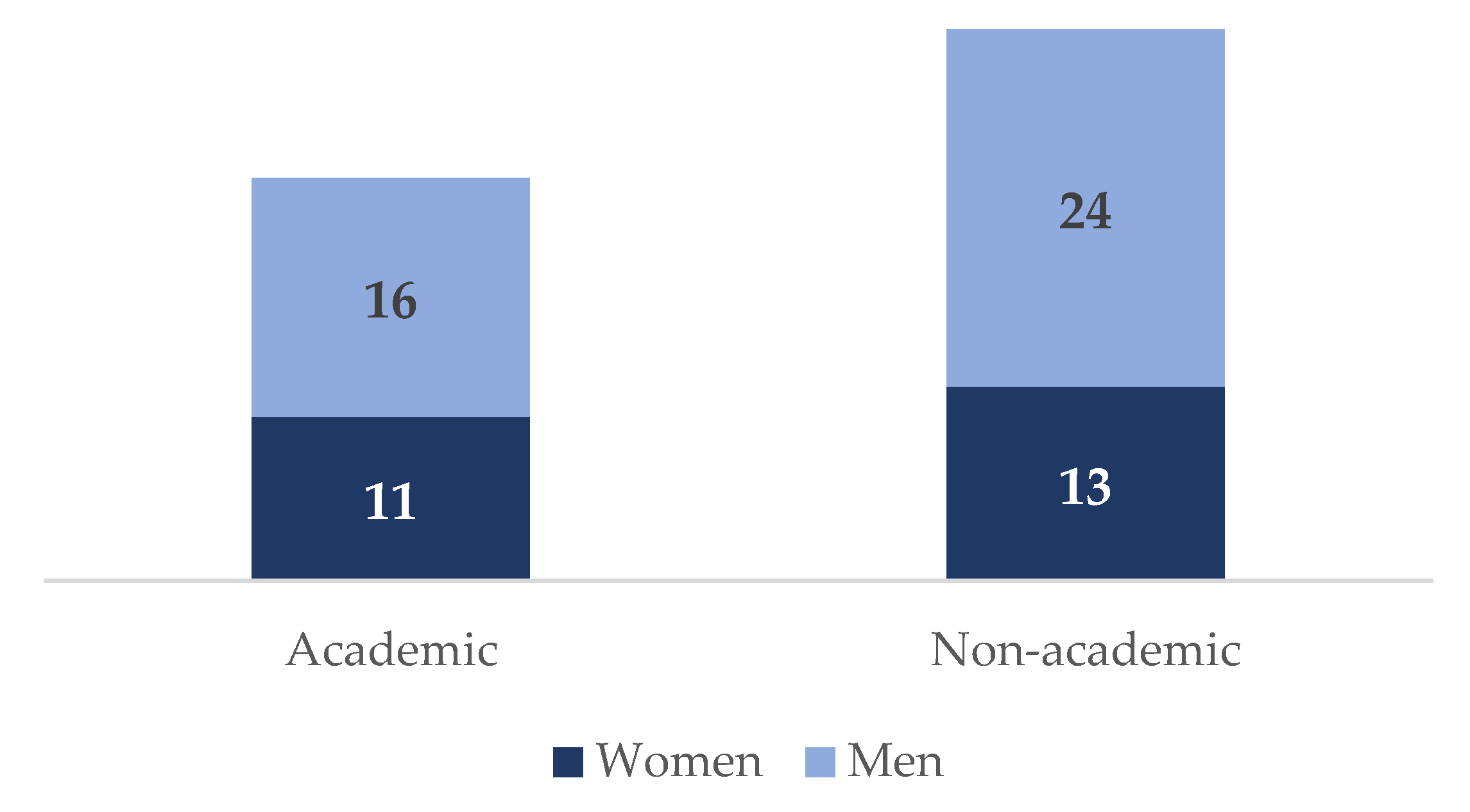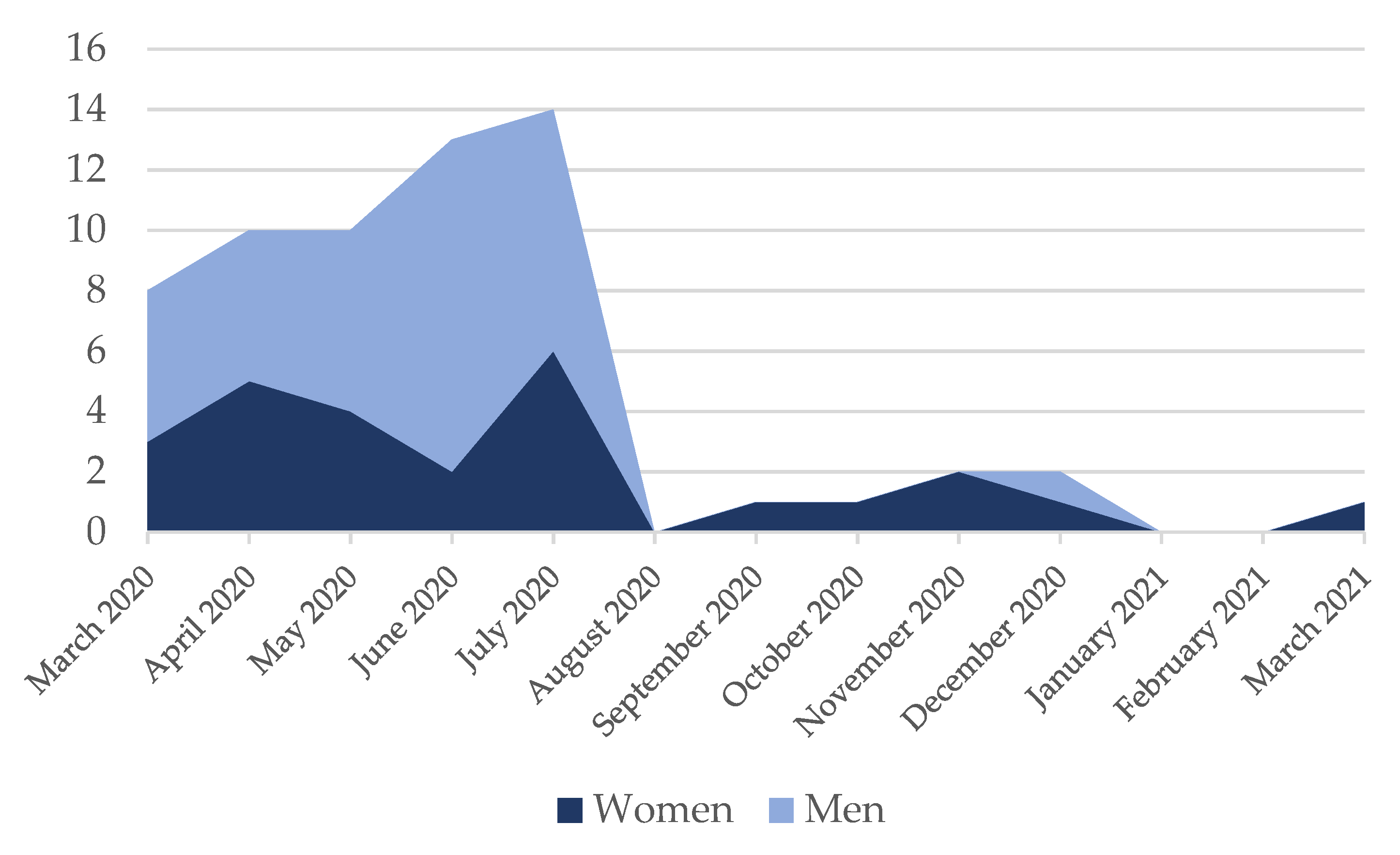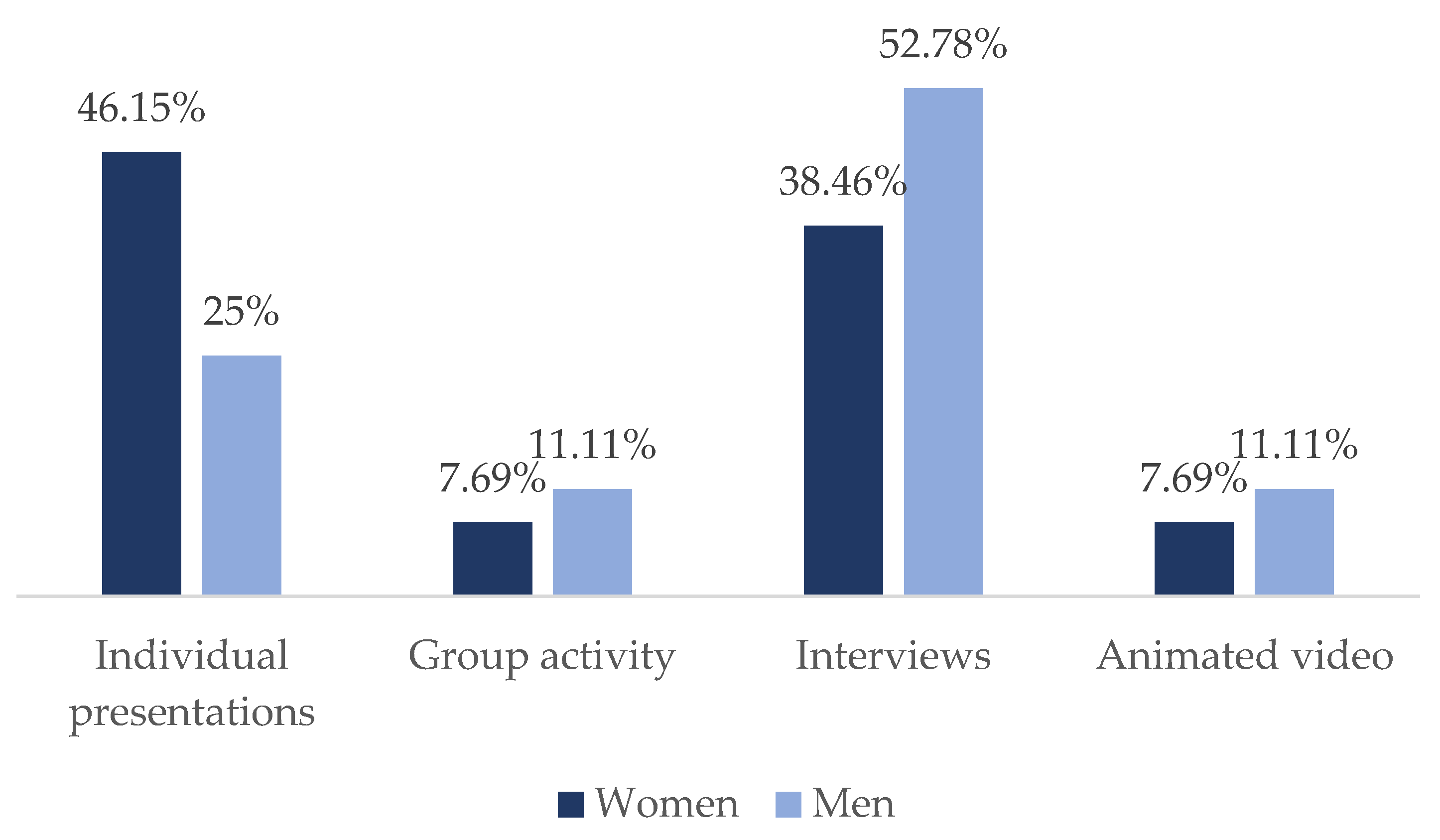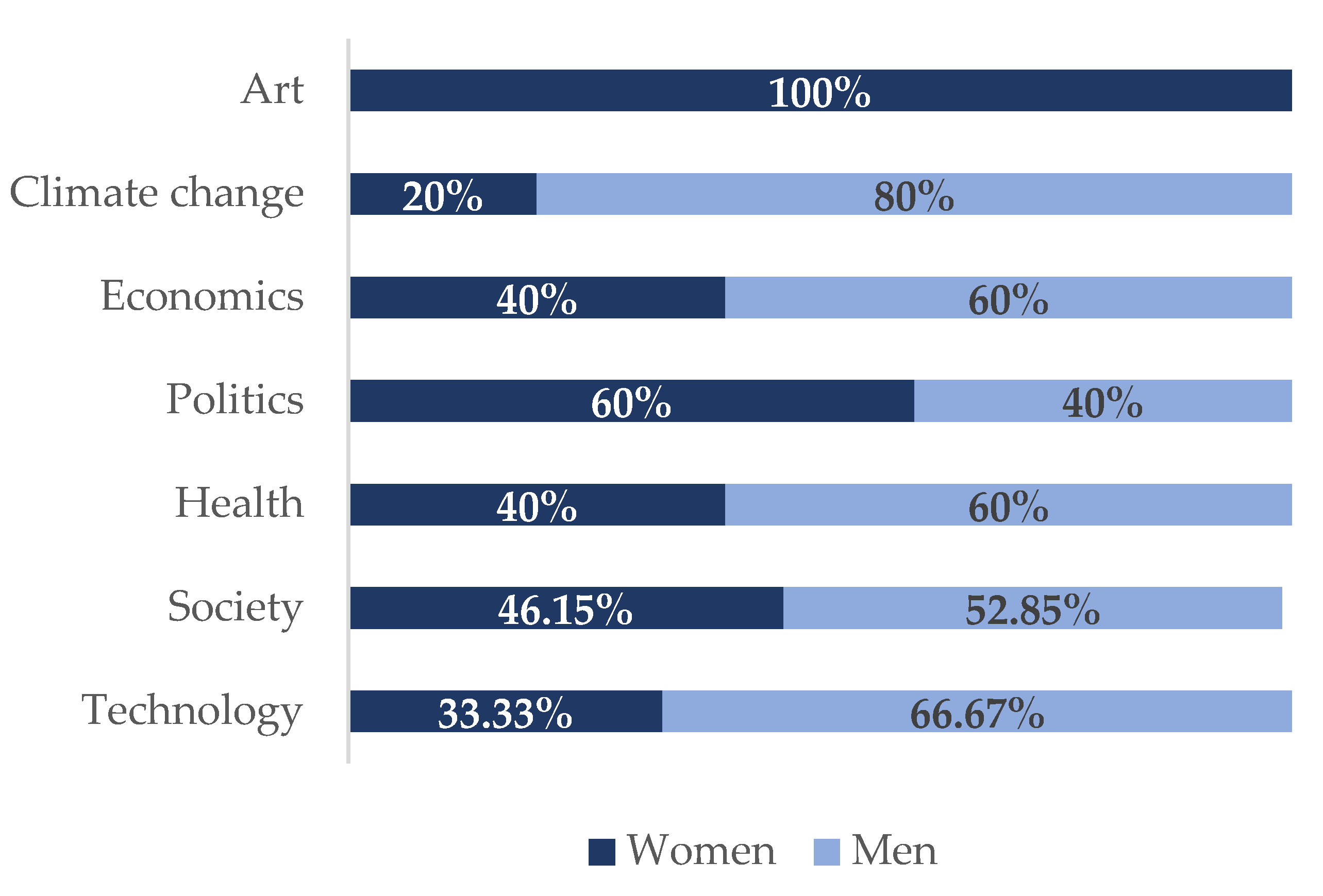Fewer and Later: Women as Experts in TED Talks about COVID-19
Abstract
:1. Introduction
2. Methodology
3. Results
3.1. Authorship of Dissemination Content
3.2. Topics
3.3. Interaction and Dialogue
4. Conclusions and Discussion
Author Contributions
Funding
Institutional Review Board Statement
Informed Consent Statement
Data Availability Statement
Conflicts of Interest
References
- Aladro, Eva, Graciela Padilla, Paula Requeijo, Dimitrina Semova, Julia García-Agustín, María Teresa García-Nieto, and Mónica Viñarás. 2014. La presencia y representación de la mujer científica en la prensa española. Revista Latina de Comunicación Social 69: 176–94. [Google Scholar] [CrossRef] [Green Version]
- Amarasekara, Inoka, and Will J. Grant. 2019. Exploring the YouTube science communication gender gap: A sentiment analysis. Public Understanding of Science 28: 68–84. [Google Scholar] [CrossRef]
- Andersen, Jeans P., Mathias W. Nielsen, Nicole L. Simone, Resa E. Lewiss, and Reshma Jagsi. 2020. Meta-Research: COVID-19 medical papers have fewer women first authors than expected. eLife 9: e58807. [Google Scholar] [CrossRef] [PubMed]
- Andreu, Jaime. 2001. Las Técnicas de Análisis de Contenido: Una Revisión Actualizada. Available online: http://mastor.cl/blog/wp-content/uploads/2018/02/Andreu.-analisis-de-contenido.-34-pags-pdf.pdf (accessed on 30 November 2021).
- Anzivino, Monia. 2021. Is public engagement gendered? An analytical proposal using some evidence from Italy. Public Understanding of Science 30: 827–40. [Google Scholar] [CrossRef]
- Cambronero-Saiz, Belén, Jesús Segarra-Saavedra, and Carmen Cristófol-Rodríguez. 2021. Análisis desde la perspectiva de género del engagement de los principales youtubers de divulgación científica= Analysis of the engagement of the main popular science youtubers from a gender perspective. Cuestiones de Género: De la Igualdad y la Diferencia 16: 511–25. [Google Scholar] [CrossRef]
- Carli, Linda, Laila Alawa, YoonAh Lee, Zhao Bei, and Elaine Kim. 2016. Stereotypes about gender and science: Women≠ scientists. Psychology of Women Quarterly 40: 244–60. [Google Scholar] [CrossRef] [Green Version]
- Casero-Ripollés, Andreu. 2020. Impact of Covid-19 on the media system. Communicative and democratic consequences of news consumption during the outbreak. El Profesional de la Información 29: e290223. [Google Scholar] [CrossRef]
- Ceron, Wilson, Mathias-Felipe de-Lima-Santos, and Marcos G. Quiles. 2021. Fake news agenda in the era of COVID-19: Identifying trends through fact-checking content. Online Social Networks and Media 21: 100116. [Google Scholar] [CrossRef]
- Chinetti, Simone. 2021. Academic Productivity and Pandemic. Evidence from Female Economists during the COVID-19 Crisis. Available online: http://www.siepweb.it/siep/images/candidati_chiuri_2021/Chinetti.pdf (accessed on 30 November 2021).
- Côté, Isabelle, and Emily Darling. 2018. Scientists on Twitter: Preaching to the choir or singing from the rooftops? Facets 3: 682–94. [Google Scholar] [CrossRef] [Green Version]
- Deryugina, Tatyana, Olga Shurchkov, and Jenna Stearns. 2021. Covid-19 disruptions disproportionately affect female academics. AEA Papers and Proceedings 111: 164–68. [Google Scholar] [CrossRef]
- Diviu-Miñarro, Clàudia, and Sergio Cortiñas-Rovira. 2020. Cómo comunicar una pandemia a la sociedad: La visión de los profesionales. Estudio de caso de la Covid-19 en el sur de Europa. El Profesional de la Informacion 29: 1–14. [Google Scholar] [CrossRef]
- Duch, Jordi, Xiao Han T. Zeng, Marta Sales-Pardo, Filippo Radicchi, Shayna Otis, Teresa K. Woodruff, and Luís A. Nunes Amaral. 2012. The possible role of resource requirements and academic career-choice risk on gender differences in publication rate and impact. PLoS ONE 7: e51332. [Google Scholar] [CrossRef] [PubMed] [Green Version]
- Eizmendi, Maider, and Simón Peña-Fernández. 2021. ¿Desaparecidas o escondidas? Análisis de la presencia de las ciencias sociales y las humanidades en las versiones online de The Guardian, El País y Público. European Public & Social Innovation Review 6: 56–69. Available online: https://pub.sinnergiak.org/esir/article/view/147 (accessed on 2 December 2021).
- Fox, Mary Frank. 2020. Gender, science, and academic rank: Key issues and approaches. Quantitative Science Studies 1: 1001–6. [Google Scholar] [CrossRef]
- Husu, Liisa, and Liisa Tainio. 2016. Representations of Women Researchers in Finnish Print Media: Top Researchers, Multi-Talents and Experts. Investigationes Feministas 7: 203–24. [Google Scholar] [CrossRef] [Green Version]
- Kalia, Vivek, Amy K. Patel, Andrew K. Moriarity, and Cheri L. Canon. 2017. Personal branding: A primer for radiology trainees and radiologists. Journal of the American College of Radiology 14: 971–75. [Google Scholar] [CrossRef]
- Kedrowicz, April A., and Julie L. Taylor. 2016. Shifting Rhetorical Norms and Electronic Eloquence: TED Talks as Formal Presentations. Journal of Business and Technical Communication 30: 352–77. [Google Scholar] [CrossRef]
- King, Molly M., and Megan E. Frederickson. 2021. The Pandemic Penalty: The gendered effects of COVID-19 on scientific productivity. Socius 7. [Google Scholar] [CrossRef]
- Krukowski, Rebecca A., Reshma Jagsi, and Michelle I. Cardel. 2021. Academic productivity differences by gender and child age in science, technology, engineering, mathematics, and medicine faculty during the COVID-19 pandemic. Journal of Women’s Health 30: 341–47. [Google Scholar] [CrossRef] [PubMed]
- Kwiek, Marek, and Wojciech Roszka. 2021. Are Female Scientists Less Inclined to Publish Alone? The Gender Solo Research Gap. arXiv arXiv:2101.03220. [Google Scholar]
- Larivière, Vincent, Chaoqun Ni, Yves Gingras, Blaise Cronin, and Cassidy R. Sugimoto. 2013. Bibliometrics: Global gender disparities in science. Nature News 504: 211–13. [Google Scholar] [CrossRef] [PubMed]
- Lerchenmueller, Marc J., Olav Sorenson, and Anupam B. Jena. 2019. Gender differences in how scientists present the importance of their research: Observational study. BMJ 367: l6573. [Google Scholar] [CrossRef] [PubMed] [Green Version]
- Mitchell, Madeline, and Merryn McKinnon. 2019. ‘Human’ or ‘objective’ faces of science? Gender stereotypes and the representation of scientists in the media. Public Understanding of Science 28: 177–90. [Google Scholar] [CrossRef]
- Mitchelstein, Eugenia, Victoria Andelsman, and Pablo Boczkowski. 2019. Joanne Public vs. Joe Public: News sourcing and gender imbalance on Argentine digital media. Digital Journalism 7: 1311–27. [Google Scholar] [CrossRef]
- Mueller, Claudia M., Dyani K. Gaudilliere, Roseanne Menorca, and Sabine Girod. 2016. Gender disparities in scholarly productivity of US academic surgeons. Journal of Surgical Research 203: 28–33. [Google Scholar] [CrossRef] [PubMed]
- Myers, Kyle R., Wei Yang Tham, Yian Yin, Nina Cohodes, Jerry G. Thursby, Marie C. Thursby, Peter Schiffer, Joseph T. Walsh, Karim R. Lakhani, and Dashun Wang. 2020. Unequal effects of the COVID-19 pandemic on scientists. Nature Human Behaviour 4: 880–83. [Google Scholar] [CrossRef] [PubMed]
- Newman, Nic, Richard Fletcher, Anne Schulz, Simge Andi, and Rasmus Kleis Nielsen. 2020. Reuters Institute Digital News Report. Oxford: University of Oxford, Available online: https://reutersinstitute.politics.ox.ac.uk/sites/default/files/2020-06/DNR_2020_FINAL.pdf (accessed on 30 November 2021).
- Palomar Verea, Cristina. 2009. Maternidad y mundo académico. Alteridades 19: 55–73. Available online: http://www.scielo.org.mx/scielo.php?script=sci_arttext&pid=S0188-70172009000200005&lng=es&tlng=es (accessed on 30 November 2021).
- Pereira, Maria do Mar. 2021. Researching gender inequalities in academic labor during the COVID-19 pandemic: Avoiding common problems and asking different questions. Gender, Work & Organization 28: 498–509. [Google Scholar] [CrossRef]
- Pérez-Dasilva, Jesús A., Koldobika Meso-Ayerdi, and Terese Mendiguren-Galdospin. 2020. Fake news y coronavirus: Detección de los principales actores y tendencias a través del análisis de las conversaciones en Twitter. Profesional de la Información 29: e290308. [Google Scholar] [CrossRef]
- Peters, Hans P., Sharon Dunwoody, Joachim Allgaier, Yin-Yueh Lo, and Dominique Brossard. 2014. Public communication of science 2.0: Is the communication of science via the “new media” online a genuine transformation or old wine in new bottles? EMBO Reports 15: 749–53. [Google Scholar] [CrossRef] [Green Version]
- Schwemmer, Caster, and Sebastian Jungkunz. 2019. Whose ideas are worth spreading? The representation of women and ethnic groups in TED talks. Political Research Exchange 1: 1–23. [Google Scholar] [CrossRef] [Green Version]
- Sierra-Rodríguez, J. 2020. Periodismo, comunicación institucional y transparencia: Aprendizajes de la crisis sanitaria del COVID-19. Revista de Comunicación y Salud: RCyS 10: 569–91. [Google Scholar] [CrossRef]
- Sugimoto, Cassidy, Mike Thelwall, Vincent Larivière, Andrew Tsou, Phillippe Mongeon, and Benoit Macaluso. 2013. Scientists Popularizing Science: Characteristics and Impact of TED Talk Presenters. PLoS ONE 8: e62403. [Google Scholar] [CrossRef]
- Tsou, Andrew, Mike Thelwall, Phillippe Mongeon, and Sugimoto Cassidy. 2014. A Community of Curious Souls: An Analysis of Commenting Behavior on TED Talks Videos. PLoS ONE 9: e93609. [Google Scholar] [CrossRef] [Green Version]
- Vázquez-Cupeiro, Susana. 2015. Science, stereotypes and gender: A review of the explanatory frameworks. Convergencia 22: 177–202. [Google Scholar]
- Vázquez-Vega, Pablo, ed. 2010. La Feminización de las Profesiones Sanitarias. Madrid: Fundación BBVA. [Google Scholar]
- Veletsianos, George, Royce Kimmons, Ross Larsen, Tonia A, Dousay T., and Patrick Lowenthal. 2018. Public comment sentiment on educational videos: Understanding the effects of presenter gender, video format, threading, and moderation on YouTube TED talk comments. PLoS ONE 13: e0197331. [Google Scholar] [CrossRef] [PubMed] [Green Version]
- Welbourne, Dustin J., and Will J. Grant. 2016. Science communication on YouTube: Factors that affect channel and video popularity. Public Understanding of Science 25: 706–18. [Google Scholar] [CrossRef]
- Wimmer, Roger, and Joseph Dominick. 1996. La Investigación Científica de los Medios de Comunicación. Barcelona: Bosch Comunicación. [Google Scholar]
- Wright, Katharine A., Toni Haastrup, and Roberta Guerrina. 2021. Equalities in freefall? Ontological insecurity and the long-term impact of COVID-19 in the academy. Gender, Work & Organization 28: 163–67. [Google Scholar] [CrossRef]




| Likes | Dislike | Comments | |
|---|---|---|---|
| Man | 11,992.22 | 1197.06 | 1998.53 |
| Woman | 9097.25 | 686.71 | 1033.66 |
| Men | Women | ||
|---|---|---|---|
| Contents | Comments | Contents | Comments |
| People | People | People | People |
| World | Virus | Health | China |
| Right | China | Public | Virus |
| Health | World | Covid | Chinese |
| Vaccine | Vaccine | Countries | Coronavirus |
| China | https | Contact | Government |
| Countries | Pandemic | World | Video |
| Virus | Video | Virus | Youtube |
| Government | YouTube | Right | World |
| Public | Gates | Crisis | Covid |
| Very Negative | Slightly Negative | Slightly Positive | Very Positive | |
|---|---|---|---|---|
| Man | 27.79% | 28.83% | 26.67% | 16.71% |
| Woman | 30.02% | 29.01% | 26.78% | 14.19% |
Publisher’s Note: MDPI stays neutral with regard to jurisdictional claims in published maps and institutional affiliations. |
© 2021 by the authors. Licensee MDPI, Basel, Switzerland. This article is an open access article distributed under the terms and conditions of the Creative Commons Attribution (CC BY) license (https://creativecommons.org/licenses/by/4.0/).
Share and Cite
Eizmendi, M.; Peña-Fernández, S. Fewer and Later: Women as Experts in TED Talks about COVID-19. Journal. Media 2021, 2, 808-818. https://doi.org/10.3390/journalmedia2040046
Eizmendi M, Peña-Fernández S. Fewer and Later: Women as Experts in TED Talks about COVID-19. Journalism and Media. 2021; 2(4):808-818. https://doi.org/10.3390/journalmedia2040046
Chicago/Turabian StyleEizmendi, Maider, and Simón Peña-Fernández. 2021. "Fewer and Later: Women as Experts in TED Talks about COVID-19" Journalism and Media 2, no. 4: 808-818. https://doi.org/10.3390/journalmedia2040046
APA StyleEizmendi, M., & Peña-Fernández, S. (2021). Fewer and Later: Women as Experts in TED Talks about COVID-19. Journalism and Media, 2(4), 808-818. https://doi.org/10.3390/journalmedia2040046







